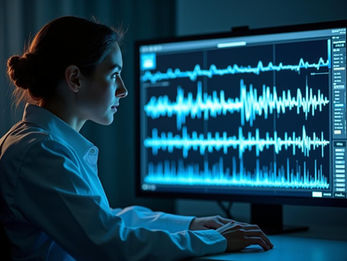top of page
BCIA Continuing Education Posts
The BioSource Faculty Explain Peer-Reviewed Science


Interpreting the Raw EEG: Four Montages
All montages compare EEG activity between one or more pairs of electrode sites.
Fred Shaffer
Jun 2016 min read


Interpreting the Raw EEG: Diffuse Beta Activity
The presence of diffuse beta is not inherently abnormal, but it does merit clinical consideration. It may reflect endogenous factors such as individual variability in cortical excitability, exogenous factors such as the use of CNS-active medications (e.g., benzodiazepines, barbiturates, certain anesthetics), or non-cerebral factors such as EMG contamination.
BioSource Faculty
Jun 1910 min read


Interpreting the Raw EEG: Rhythmic Mid-Temporal Theta of Drowsiness (RMTTD)
In recordings of drowsy subjects, RMTTD often coexists with slowing of the posterior dominant rhythm and the emergence of vertex sharp waves, further supporting its link to transitional drowsiness states rather than to epilepsy or cortical dysfunction.
Fred Shaffer
Jun 198 min read


Interpreting the Raw EEG: Slow Alpha
Not all slow alpha is a pathological sign. A subset of these slow rhythms, especially when reactive and morphologically stable, represents not a degradation of function but a subharmonic of the canonical posterior dominant rhythm (PDR), generated by the same resonant thalamocortical loop but oscillating at half the fundamental frequency.
BioSource Faculty
Jun 1914 min read


Interpreting the Raw EEG: Fast Alpha
The most pressing clinical issue surrounding fast alpha is its frequent misclassification, particularly when spectral peaks in the 18–19 Hz range are erroneously interpreted as beta spindling, pathological fast activity, or early signs of drug effects.
BioSource Faculty
Jun 1812 min read


Interpreting the Raw EEG: Alpha Squeaks
We wish clinicians—particularly those interpreting pediatric EEGs—understood that alpha squeaks are normal, age-appropriate findings that reflect an active but immature visual-cortical network.
BioSource Faculty
Jun 1810 min read


Interpreting the Raw EEG: Temporal Intermittent Rhythmic Delta Activity (TIRDA)
The most common diagnostic pitfall occurs when TIRDA is misread as nonspecific temporal slowing. Many readers unfamiliar with its focal rhythmic structure mistakenly attribute it to background slowing due to prior injury or generalized dysfunction.
BioSource Faculty
Jun 1813 min read


Interpreting the Raw EEG: Occipital Intermittent Rhythmic Delta Activity (OIRDA)
We wish clinicians knew that OIRDA is not an epileptiform discharge. It does not reflect hyperexcitability or paroxysmal depolarization, and in isolation, it is not a seizure pattern.
Fred Shaffer
Jun 1716 min read


Interpreting the Raw EEG: Triphasic Waves
Triphasic waves are among the most recognizable and clinically meaningful non-epileptiform EEG patterns encountered in patients with altered mental status.
BioSource Faculty
Jun 1714 min read


5-Min Science: Your Brain Emits Biophotons
The idea that the brain might not just glow but use this glow as part of its signaling has remained speculative—until now.
Fred Shaffer
Jun 167 min read


The Clinician Detective: Investigation Begins with Careful Observation
Before a diagnosis of a mental disorder can be made, the clinician must rule out that the symptoms are not attributable to the physiological effects of a substance or another medical condition.
Fred Shaffer
Jun 1614 min read


How Benzodiazepines Affect the EEG
Benzodiazepines vary widely in EEG and clinical effects—Subtypes differ by half-life and receptor affinity, influencing sedation, rebound symptoms, and cortical modulation.
Fred Shaffer
Jun 1614 min read


How Antidepressants Affect the EEG
Antidepressants, particularly those that are highly activating or serotonergically potent, may be the worst choice in patients with SEB, IEDs, or focal abnormalities.
Fred Shaffer
Jun 1532 min read


5-Min Science: Nasal Respiratory Fingerprints
Breathing may serve not only as a marker of psychological traits but potentially as a modulator, aligning with emerging work on respiratory-based therapies for anxiety and depression.
BioSource Faculty
Jun 138 min read


Dr. John Davis on the Alpha Rebound Protocol for PTSD
Reduced alpha rhythms in PTSD are thought to be involved in poor excitatory/inhibitory balance in the brain.

John Davis
Jun 1314 min read


BCIA's New Performance Certification Designation
The Biofeedback Certification International Alliance (BCIA) is introducing a new performance-focused certification designation.
Fred Shaffer
Jun 113 min read


5-Min Science: How We Distinguish Reality from Imagination
Dijkstra and colleagues identified a specific neural mechanism that our brains use to distinguish the vivid world of our imagination from the tangible reality we perceive through our senses.
Fred Shaffer
Jun 114 min read


5-Min Science: HRV Biofeedback Can Reduce Anger in Teenagers with ASD
Dr. Heidi Hillman’s (2025) study explored the application of heart rate variability (HRV) biofeedback to reduce anger in autistic adolescents.
BioSource Faculty
Jun 104 min read


Lynda Thompson on Neurofeedback and Biofeedback Synergy
A growing body of research and clinical innovation has underscored the need to integrate multiple therapeutic modalities like neurofeedback and biofeedback when working with clients who present with complex psychological and physiological concerns.
Fred Shaffer
Jun 103 min read


Patrick Steffen and Travis Anderson Revise The Transactional Model
Steffen and Anderson’s synthesis of recent neuroscience advances proposes a fundamental shift in how we understand stress and coping.
BioSource Faculty
Jun 103 min read
bottom of page
